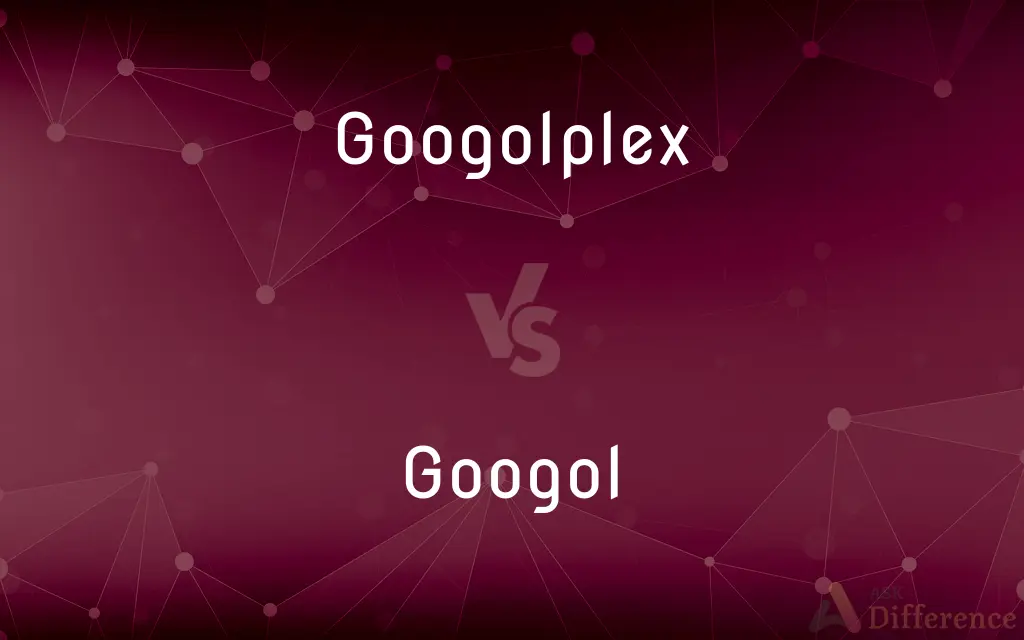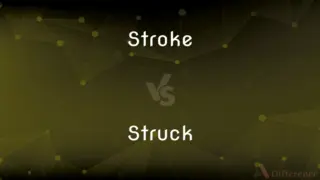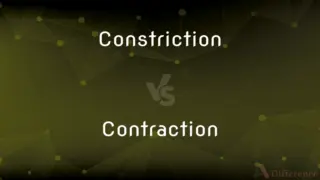Googolplex vs. Googol — What's the Difference?
By Tayyaba Rehman & Fiza Rafique — Updated on April 3, 2024
A googol is a 10^100, a digit followed by 100 zeros, while a googolplex is 10 to the power of a googol, an unimaginably larger number.

Difference Between Googolplex and Googol
Table of Contents
ADVERTISEMENT
Key Differences
A googol, representing a 1 followed by 100 zeros, was coined to provide a sense of just how large certain numbers can be, far exceeding quantities we encounter in everyday life or even in conventional scientific calculations. On the other hand, a googolplex takes this concept to an extreme, defined as 1 followed by a googol of zeros. The magnitude of a googolplex illustrates the limits of what we can practically comprehend or represent in physical form, given that the number of elementary particles in the observable universe is vastly smaller than a googolplex.
While a googol itself is already beyond practical application in terms of quantifiable objects or measurements in the universe, a googolplex is so large that writing out even a fraction of its zeros with all the matter in the universe would be impossible. This stark difference highlights the conceptual nature of such numbers, primarily used in theoretical discussions rather than practical mathematics or science.
The concept of a googol was introduced by nine-year-old Milton Sirotta, the nephew of mathematician Edward Kasner, to give a name to a specific large number. Kasner then went a step further with a googolplex to demonstrate the difference between an unimaginably large number and infinity. Despite their size, both numbers are finite, illustrating the idea that numbers can always continue to grow.
The introduction of googol and googolplex has also had cultural and educational impacts, making their way into discussions not just about mathematics but also about the nature of infinity and the scale of the universe. They serve as useful tools for teaching about exponents and the concept of largeness in numbers.
Despite the vast difference in their magnitudes, both googol and googolplex play a similar role in the mathematical landscape: they are finite numbers that challenge our understanding of scale and quantity, pushing the boundaries of what we consider to be large, yet they remind us that even these numbers are but a speck on the continuum towards infinity.
ADVERTISEMENT
Comparison Chart
Definition
10^(10^100) (1 followed by a googol of zeros)
10^100 (1 followed by 100 zeros)
Origin
Concept extended by Edward Kasner
Coined by Milton Sirotta, 9, in 1920s
Physical Representation
Far exceeds the number of atoms in the observable universe
Impossible to physically represent but smaller than a googolplex
Practical Use
Even more theoretical, illustrating numbers beyond comprehension
Mostly theoretical, used to illustrate large numbers
Relation to Infinity
Finite, but even further illustrates the vastness before reaching infinity
Finite, but helps conceptualize the journey towards infinity
Compare with Definitions
Googolplex
Cannot be physically represented.
Not enough matter in the universe exists to write down a googolplex.
Googol
A specific large number: 10^100.
A googol is vastly greater than the number of grains of sand on all the world's beaches.
Googolplex
Theoretical concept in mathematics.
A googolplex is more of a conceptual number used in theoretical discussions.
Googol
Coined to demonstrate large quantities.
The concept of a googol helps people understand the magnitude of numbers in the universe.
Googolplex
An even larger number: 10^(10^100).
A googolplex is so large, it's impossible to write out in standard decimal form.
Googol
Beyond practical quantities.
Even the stars in the universe are fewer than a googol.
Googolplex
Illustrates numbers beyond comprehension.
Thinking about a googolplex challenges our understanding of large numbers.
Googol
Symbolizes large but finite numbers.
A googol is a finite number, illustrating that numbers can always grow larger.
Googolplex
Represents the vastness before infinity.
A googolplex is finite but helps illustrate the concept of approaching infinity.
Googol
Basis for the name of Google.
The search engine Google derived its name from the mathematical term googol, representing vast amounts of information.
Googolplex
A googolplex is the number 10googol, or equivalently, 10(10100). Written out in ordinary decimal notation, it is 1 followed by 10100 zeroes; that is, a 1 followed by a googol zeroes.
Googol
A googol is the large number 10100. In decimal notation, it is written as the digit 1 followed by one hundred zeroes: 10,000,000,000,000,000,000,000,000,000,000,000,000,000,000,000,000,000,000,000,000,000,000,000,000,000,000,000,000,000,000,000,000,000.
Googolplex
The number 10 raised to the power googol, written out as the numeral 1 followed by 10100 zeros.
Googol
The number 10 raised to the power 100 (10100), written out as the numeral 1 followed by 100 zeros.
Googolplex
The number or , ten to the power of a googol.
Googol
The number , or ten to the power of a hundred. Equivalent to ten duotrigintillion (short scale), or ten sedecilliard (long scale).
Googolplex
(figuratively) A countable number
Googol
A cardinal number represented as 1 followed by 100 zeros (ten raised to the power of a hundred)
Googolplex
An infinitesimally small portion of land, defined for legal purposes.
Googolplex
A cardinal number represented as 1 followed by a googol of zeros (ten raised to the power of a googol)
Common Curiosities
Why are googol and googolplex important in mathematics?
They serve as examples to illustrate concepts of largeness and the difference between very large finite numbers and infinity.
Can a googolplex be used in calculations?
In practical terms, no, because its magnitude exceeds the capacity of physical representation or any practical application.
Can we comprehend the size of a googolplex?
Comprehending the full scale of a googolplex is beyond human ability, as it far exceeds the number of particles in the observable universe.
Are googol and googolplex the largest numbers?
No, they are large but finite numbers, and larger numbers can be defined, such as "googolplexian" or using mathematical notations for even greater magnitudes.
Have googol and googolplex been used in any mathematical proofs?
While not typically used in proofs, they are useful in discussions about the nature of large numbers and theoretical mathematics.
Is there anything larger than a googolplex in the universe?
In terms of physical objects or quantities, no; but mathematically, numbers larger than a googolplex can be easily constructed.
Can you write down a googolplex?
It is not feasible to write down a googolplex in its entirety, as it would require more space and time than exists in the observable universe.
How did Google get its name from googol?
The company's founders chose the name as a play on the word "googol," reflecting their mission to organize a seemingly infinite amount of information on the web.
What's the point of defining such large numbers as googol and googolplex?
Defining such large numbers helps in understanding the scale of numerical values and the concept of infinity in a more tangible way.
Could a computer calculate a googolplex?
A computer cannot store or process a googolplex in its numerical form due to its unimaginable size.
How was the googol created?
The googol was created by Milton Sirotta, the nephew of mathematician Edward Kasner, as a way to name a very large number.
Are there practical applications for a googol?
The googol is mostly used for educational and illustrative purposes, rather than practical applications.
What does the concept of a googolplex say about infinity?
It illustrates that no matter how large a number might be, it is still finite and distant from the concept of infinity.
Is the concept of a googolplex purely theoretical?
Yes, the googolplex is a theoretical number used to convey the idea of very large quantities beyond physical realization.
Share Your Discovery

Previous Comparison
Stroke vs. Struck
Next Comparison
Constriction vs. ContractionAuthor Spotlight
Written by
Tayyaba RehmanTayyaba Rehman is a distinguished writer, currently serving as a primary contributor to askdifference.com. As a researcher in semantics and etymology, Tayyaba's passion for the complexity of languages and their distinctions has found a perfect home on the platform. Tayyaba delves into the intricacies of language, distinguishing between commonly confused words and phrases, thereby providing clarity for readers worldwide.
Co-written by
Fiza RafiqueFiza Rafique is a skilled content writer at AskDifference.com, where she meticulously refines and enhances written pieces. Drawing from her vast editorial expertise, Fiza ensures clarity, accuracy, and precision in every article. Passionate about language, she continually seeks to elevate the quality of content for readers worldwide.
















































